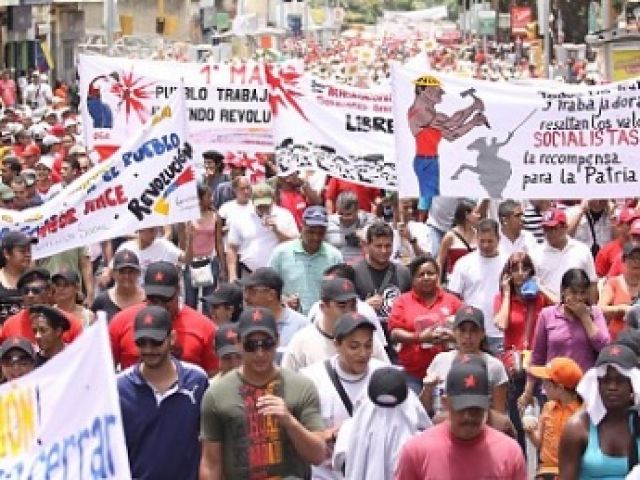
We have just finished a very successful May Day brigade to Venezuela, organised by the Australia-Venezuela Solidarity Network (AVSN). The majority of the 14 participants were from Australia, with two Canadians and one from the US also taking part.
May Day was, of course, a highlight of the 10-day tour: more than 1 million marchers, all in red t-shirts. Brigadistas were greeted with cheers of welcome — we were easily identified by our Australian solidarity activists shirts and banner.
Our first few days were spent in Caracas visiting the Endogenous Zone of Fabricio Ojada in Catia. There we saw a Barrio Adentro — a second-stage clinic for Venezuela’s new free health system — a shoe and a t-shirt factories.
We also attended a concert of colonial songs as the country was celebrating 200 years of independence from Spanish colonisation. The Venezuelan tourism department has organised a tour around colonial parts of Caracas, with actors playing the role of Negro Hipolyta, Simon Bolivar’s nurse, the dictator General Gomez and the poet Andres Eloy Blanco, among others.
The brigade included unionists the Construction Forestry Mining Energy Union, the Australian Manufacturing Workers Union and the Maritime Union of Australia. The unionists attended the Venezuelan National Union of Workers conference on April 24.
We also met with the women’s bank, Banmujer, and the indigenous parliament.
We travelled to the industrial area of Puerto Ordaz to visit some large factories. This section of the brigade was organised by Alexis Adarfio, who is coming to Australia in late May to talk about the changes taking place in Venezuela. Tamara Pearson, an Australian solidarity activist living in Venezuela, also helped organise the brigade.
One highlight was the tour of a brick factory that was taken over by workers. The management was about to abandon the factory, despite owing large sums of money to the workers. The workers blocked the gates with trucks and forklifts, locking the managers in their offices for three days.
They were released after three days: under Venezuelan law, more than 72 hours constitutes a kidnapping offence. The Venezuelan government then bought out the owners and the workers are now running the brick factory themselves.
Back in Caracas, we visited the Barrio 23 Enero neighbourhood, whose people played a big role in the overturn of the April 2002 coup and the release of President Hugo Chavez. We were given food and shelter by the staff at the Ateneo Popular, which provides cheap accommodation for those involved in solidarity work.
We also heard talks by Dr Marcelo Alfonzo, Green Left Weekly Caracas bureau member Kiraz Janicke and author Eva Golinger on Venezuelan history and the current political situation. Venezuela Analysis journalist Tamara Pearson played a big role in helping with the brigade.
It was a very stimulating brigade, the tenth organised by AVSN. Everyone gained a lot of information and inspiration from their participation.